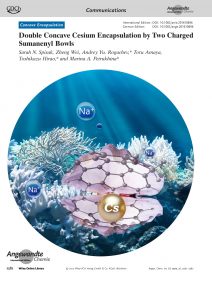 Breakthrough research into the structure of non-planar polyaromatic molecules by the research group of Andrey Rogachev, assistant professor of chemistry, is featured on the frontispiece of the January issue of Angewandte Chemie International Edition (impact factor 12). This study represents a highly efficient combination of accurate theoretical predictions and experimental justification.
Breakthrough research into the structure of non-planar polyaromatic molecules by the research group of Andrey Rogachev, assistant professor of chemistry, is featured on the frontispiece of the January issue of Angewandte Chemie International Edition (impact factor 12). This study represents a highly efficient combination of accurate theoretical predictions and experimental justification.
Starting from the very beginning of their history, non-planar polyaromatic molecules (a.k.a. fullerene fragments or buckybowls), systems that combine properties and features of planar graphene-like materials and closed-cage fullerene, were assumed to be used for metal encapsulation. However, in more than four decades of looking, no researcher found evidence of such encapsulation – no endo-coordination by metals, only exo, i.e., no encapsulation.
Rogachev and his collaborators solved the 40-year-old puzzle. Based on comprehensive theoretical investigation of different systems/models performed by the Rogachev group, his experimental collaborators from State University of New York (SUNY) at Albany and Osaka University were able to eventually synthesize the molecule, where cesium cation is jammed between endo-surfaces of two sumanene anions. Thus, the first metal encapsulation of metal cation between two curved polyaromatic molecules is now a reality.
“This is an excellent example of theory-guided experimental discovery,” said Rogachev. “It opens the door to the new supramolecular chemistry of buckybowls, the chemistry of the endo-surface.”
